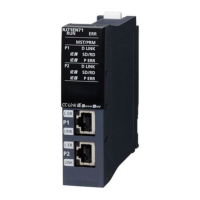26
4 FUNCTIONS
4.2 Cyclic Transmission
4.2 Cyclic Transmission
This function communicates data periodically among stations on the network using link devices.
• The link devices can be assigned in "Network Configuration Settings" under "Basic Settings". ( Page 140 "CC-Link IE
TSN Configuration" Window)
• The link refresh is assigned in "Refresh Settings" under "Basic Settings". ( Page 133 Refresh settings)
Cyclic transmission operates as follows with the communication mode set by the module parameter of the master station.
• When communicating in multicast mode, the local station cannot receive RX and RWr sent by the CC-Link
IE TSN Class A remote station. ( Page 31 At multicast mode)
• To allow the local station to obtain RX and RWr sent by the CC-Link IE TSN Class A remote station, use the
program to send RX and RWr from the master station to the local station. ( Page 170 Examples of
Communication with CC-Link IE TSN Class A Remote Stations)
• When communicating in multicast mode, set "Communication Period Setting" for the local station under
"Network Configuration Settings" to "Basic Period".
• If a data link error occurs in multicast mode, ERROR LED at the local station flashes. However, even if a
data link error occurs at the CC-Link IE TSN Class A remote station during data link, ERROR LED at the
local station does not flash. (The LED remains off.)
• When communicating in multicast mode, 'Data link error status of each station' (SB00B0) and 'Total number
of device stations present value' (SW0059) at the local station can be checked by SB and SW. However, the
information of the CC-Link IE TSN Class A remote station may not be checked by some SB and SW.
Communication mode Description
Unicast mode • Cyclic data is sent to one station.
• When this communication mode is used, the local station cannot receive cyclic data from another station. Use this mode
when there is no local station or when it is not required for the local station to receive cyclic data from another station.
• The cyclic transmission time of this mode is shorter than the cyclic transmission time of multicast mode. ( Page 286
Communication cycle intervals)
Multicast mode • Cyclic data is sent to multiple stations.
• When this mode is used, the local station can receive cyclic data from another station. Use this mode when it is required for
the local station to receive cyclic data from another station.
• The cyclic transmission time of this mode is longer than the cyclic transmission time of unicast mode. ( Page 286
Communication cycle intervals)

